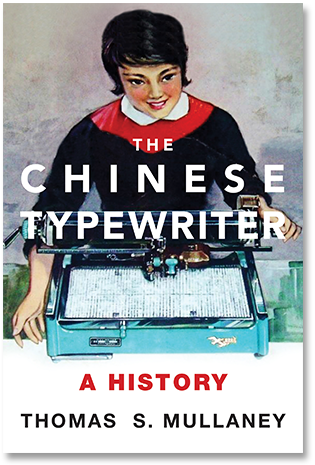Tech books for Christmas: Food for thought

Despite the come-hitherness of the title Robot Sex, a couple of these 'I-need-a-gift-for-a-geek' books are the sort where you may want to be out of town when the recipient calls you, depressed, with their feedback. But they're all worth it.

The Chinese Typewriter: A History • by Thomas S. Mullaney • MIT Press • 485 pages • ISBN: 978-0-262-03636-8 • $34.95/£27.95
The most fun of the lot is Thomas S Mullaney's The Chinese Typewriter: A History.
It's easy to forget that the ubiquitous single-shift typewriter keyboard, designed specifically for our relatively simple 26-letter alphabet and limited use of capital letters (2.5 percent to five percent of text), had competitors when it was originally designed. A typewriter for the Chinese language, which has some 47,000 characters but no alphabet or syllabic structure, seemed so absurd in 1900 that people published cartoons lampooning the idea (which Mullaney reprints).
Reading Mullaney sends you looking for more details of those typewriter designs not taken.
On a Lambert keyboard, pushing a button on a dial swivelled the right letter into place. Double-keyboard machines separated upper and lower case into two tiers, like an organ -- and turned out to be almost perfect for the much larger Siamese alphabet.
The engineers behind the shift-keyboard monoculture proved adaptable in many ways, making adaptations for right-to-left writing (Arabic and Hebrew), accents, and much larger alphabets. Chinese, however, inspired a technology-first attitude that is with us still, as manufacturers like Olivetti and Remington advertised that their modern technology was wonderful, but that Chinese was ancient, unsuited for serious thought, and needed to adapt.
And yet the Chinese went on to invent the first -- analog -- version of what we now call predictive text when typewriter engineers sought to make the machines more efficient. Along the way, different designs adopted very different paradigms: one attempted to break up Chinese characters into reusable components; another had a system of myriad rollers and a master key that could create up to 90,000 characters (although was never commercially produced).
Mullaney's main point is worth remembering: in a monoculture, other options collapse out of view and we lose the ability to imagine alternative approaches.
There's an insufficiently appreciated rule that every subject sounds more interesting with the word 'forensic' inserted in front of it. 'Forensic' turned anthropology into a detective career, a clutch of bestselling crime novels, and the 12-season TV series Bones for Kathy Reichs.
Just as that discipline studied the marks left on bones to detect crime, so forensic architecture uses changes in the built landscape to understand what happened to the humans in and around them. The Forensic Architecture Group, led by principal investigator Eyal Weizman, is based at Goldsmiths, University of London. Now, Weizman has written the copiously illustrated book Forensic Architecture: Violence at the Threshold of Detectability to describe their work for a wider audience.
Forensic Architecture: Violence at the Threshold of Detectability • by Eyal Weizman • Zone Books • 368 pages • ISBN: 9781935408864 • $39.95/£32.95
The closest analog to the group's work is probably Patrick Ball's efforts with the Human Rights Data Analysis Group, which turns personal testimony and other data streams into scientifically rigorous statistics that show who did what to whom. Weizman's group analyzes the common elements of buildings and other structures, their representations, and data about them to produce evidence about what happened that they then present to international courts, truth commissions, tribunals, and other forums.
The first section of the book explains what forensic architecture is, and the evolution and practice of the methods the group uses. The second part is a case worked out in detail: the reconstruction of two related deadly incidents that took place in Palestine in 2014. The group's work is exhilarating for anyone who appreciates the creative leap it takes to develop a new set of investigative tools with such rigour.
Enemies Known and Unknown: Targeted Killings in America's Transnational War • by Jack McDonald • Hurst • 318 pages • ISBN: 978-1-84904-644-2 • £17.99
The targeted killings Jack McDonald (Kings College London) studies in Enemies Known and Unknown are the result of a profound change in the way war is waged.
While this is not overtly a technology book, many of the challenges to international law that McDonald teases out are the result of a mix of social and technology trends. War has traditionally meant physical violence between nations; but 'wars' on poverty, drugs, and terrorism are transnational fights between ideologies, not geographies. US actions are McDonald's focus here, but as he warns, what one nation does, others may copy.
Before Babylon, Beyond Bitcoin: From Money That We Understand to Money That Understands Us • By David Birch • London Publishing Partnership • 264 pages • ISBN: 978-1-907994-65-4 • £22.41
Technology, David Birch writes in Before Babylon, Beyond Bitcoin, has long enabled new forms of money: coins could not exist before smelting, nor bank notes before printing.
Today's hottest speculative asset, bitcoin, required cheap enough computing power to perform cryptographic calculations. Birch has argued previously that the future of money is identity. In this book, he predicts that governments will cease to be the sole issuers of money, that instead money will be issued by all kinds of communities. Brixton pounds, Ithaca hours, frequent flyer miles, Amazon gift cards, World of Warcraft gold... all of these are currencies of value to their users. The only currency Birch wants dead is cash.
The future of money, he writes, began in 1971, when US President Richard Nixon dumped the gold standard. Today, every country's money is fiat currency, not tethered to physical assets. Therefore, he argues, what's the difference between ningis and Yap stone disks? Your mobile phone will negotiate the currency and amount on your behalf, and you don't have to know anything. It's all just numbers in cyberspace, right? Agree with him or not, his book is thought-provoking.
Robot Sex • Edited by John Danaher and Neil McArthur • MIT Press • 328 pages • ISBN: 9780262036689 • $40/£32.95
Robot Sex: Social and Ethical Implications is not going to inspire any Daily Mail headlines. Instead, the essays selected by editors John Danaher and Neil McArthur consider the implication of sex with robots.
For the purposes of these authors, 'sex robot' is defined as: humanoid, human-like in movement and behaviour, and possessed of some degree of artificial intelligence. The definition does its intended job, which is to raise questions worth discussing.
Many of the questions are familiar: whether love is possible between a human and a robot, a redressed way to ask whether an AI can achieve consciousness. Others are familiar from previous similar debates about pornography -- for example, whether humans with robot sex partners become less tolerant of the foibles of human ones.
The conclusion of the chapter on whether it's justifiable to campaign against sex robots is given away by the presence of the Future of Humanity Institute's Anders Sandberg among the co-authors, who has never met a non-killer robot he didn't like: it concludes the harm is speculative and vague, and stopping the robots is likely to be ineffective. And, inevitably, someone -- Twente University's Litska Strikwerda -- has to ask about the legal and moral implications of child sex robots. To answer that, Strikwerda reviews prior controversies about entirely computer-generated sexual abuse images: these are illegal in most countries, and Strikwerda concludes that child sex robots will have to be also.
The point of this book is to tease out the distinguishing characteristics of robots so we're ready when it's time to develop laws about them. For now, it's speculation. Roxxxy, which was presented at the AVN Adult Entertainment Expo in 2010 as the world's first sex robot, and which is referenced in this book, is not known to be in commercial production, even though the manufacturer's website offers it for a shade under $10,000.
Read more book reviews
- Children online: Two books that accentuate the positive
'Screenwise' provides advice on guiding kids through the digital world, while 'Worried About the Wrong Things' urges more focus on the opportunities available to children online. - The San Francisco Fallacy, book review: Unconventional wisdom
Jonathan Siegel's book challenges the received wisdom about startup culture, and is a useful reference for anyone thinking of creating or joining a new business. - Post-Truth, book review: The facts about 'alternative facts'
Fake news has been around far longer than last year's US Presidential election and the Brexit vote, but the internet allows BS to spread further than ever. - A Mind at Play, book review: The life and work of information theory's founding father
You can use the internet without understanding any of Claude Shannon's work. But there is value in knowing how the technologies we use every day got here. This excellent biography is a good place to start. - Crash Override, book review: Gamergate and the battle against online hate
Game developer Zoë Quinn recounts her experience of 'Gamergate', which prompted the creation of the Crash Override Network to provide support and advice for victims of online hate.